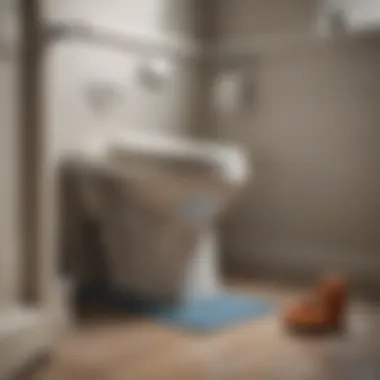Effective Methods to Dissolve Toilet Clogs


Intro
Toilet clogs represent a common challenge for many homeowners. They can disrupt daily routines and can lead to more extensive plumbing issues if not addressed properly. Understanding effective methods to dissolve these clogs is essential for maintaining the efficiency of your plumbing system.
This article will uncover various techniques, focusing on both chemical and natural solutions. Whether you are dealing with an immediate clog or looking for preventive measures, the insights provided here will serve as a comprehensive guide to tackling this household inconvenience.
It is crucial to note that the effectiveness of these methods can depend on the nature of the clog. Therefore, identifying the cause is the first step in determining the best solution.
Understanding Toilet Clogs
Clogs occur due to various reasons, such as excessive toilet paper use, foreign objects, or even built-up minerals. In many instances, a simple solution is all that is needed to restore functionality. With knowledge of both chemical and natural methods, you can choose the most appropriate approach tailored to your situation.
Common Causes of Toilet Clogs
- Excessive toilet paper: Using an excessive amount can create a blockage.
- Non-flushable items: Items like wipes and feminine hygiene products often do not dissolve and lead to clogs.
- Mineral build-up: Hard water can cause minerals to accumulate, resulting in gravity-driven clogs.
Why Address Clogs Promptly
Ignoring a clog may seem harmless at first but can quickly escalate. Continued use of a clogged toilet can lead to overflow or pipe damage. Therefore, addressing the problem without delay is important.
Understanding Toilet Clogs
Toilet clogs are a common annoyance in households that can lead to discomfort and disruption in daily routines. Addressing this issue effectively requires a clear understanding of what causes clogs and how to identify them. By grasping the fundamentals of toilet clogs, homeowners can be proactive about prevention and more efficient when tackling issues.
Common Causes of Toilet Clogs
There are several factors that contribute to toilet clogs, and recognizing these can help in finding effective solutions:
- Excessive Toilet Paper Use: This is perhaps the most typical reason for clogs. A large volume of toilet paper can combine with water to form a blockage that is difficult to dislodge.
- Inappropriate Items Flushed: Items such as feminine hygiene products, wipes, and other foreign objects should never be flushed. These materials do not break down and can easily create blockages.
- Mineral Build-Up: Hard water can lead to mineral deposits accumulating in the toilet pipes, reducing their width and increasing the likelihood of clogs.
- Poor Pipe Design: In some cases, the plumbing layout may not be optimal, leading to natural barriers that facilitate clogs.
- Flapper Issues: A malfunctioning flapper can allow water to leak from the tank and create low water levels in the bowl, increasing the risk of clogs.
Awareness of these causes can significantly aid in preventing clogs before they even occur.
Signs of a Toilet Clog
Identifying a toilet clog early can save time and trouble. Here are some clear indications:
- Slow Draining: If water is slow to drain from the bowl after flushing, it could be a sign of a clog forming.
- Gurgling Noises: Unusual sounds when flushing often indicate air trapped in the plumbing system due to a blockage.
- Water Backing Up: If water starts to rise in the bowl instead of draining, this is a clear sign that a clog is present.
- Foul Odors: Persistent unpleasant smells can indicate a blockage or build-up of waste material in the pipes.
- Frequent Clogs: If clogs happen often, it may suggest an underlying plumbing issue or poor maintenance practice.
Recognizing these signs allows for prompt action, preventing more severe plumbing issues in the future. Understanding the fundamental aspects of toilet clogs equips homeowners with insights essential for effective maintenance and resolution.
Chemical Solutions for Toilet Clogs
Chemical solutions serve a critical role in addressing toilet clogs. They can be particularly effective when physical methods fall short. These solutions often target various types of blockages, such as those formed by organic matter or products that do not dissolve easily in water. Choosing the right chemical solution can lead to faster results, ultimately restoring functionality to the plumbing system with minimal effort.
Traditional Drain Cleaners


Composition and Mechanism
Traditional drain cleaners are primarily composed of harsh chemicals, such as sodium hydroxide or hydrochloric acid. These substances work by breaking down clogs through a strong exothermic reaction. This means they generate heat, which can help to liquefy solid waste and grease. One key characteristic is their ability to tackle tough blockages effectively. However, the drawbacks include potential damage to pipes if used excessively. Also, safety precautions must be strictly followed to avoid any harm to the user.
Application Guidelines
When applying traditional drain cleaners, following the manufacturer's instructions is critical. Typically, users should pour the cleaner directly into the toilet bowl and allow it to sit for a specified time before flushing. This method provides ample time for the chemicals to work effectively. The unique feature of these guidelines is their straightforward approach, making it easy for even inexperienced users to implement. However, it is essential to consider that prolonged use of these chemicals could lead to pipe deterioration.
Enzyme-Based Cleaners
Effectiveness and Usage
Enzyme-based cleaners leverage biologically active ingredients to break down organic materials. Their effectiveness lies in the capacity to digest waste over time, rather than relying on chemical reactions. This gradual approach means they are less aggressive and often considered safer for plumbing systems. One appealing feature is that they are designed to tackle recurring clogs. However, the downside is that enzyme-based solutions can take longer to yield visible results compared to more aggressive chemical cleaners.
Environmental Considerations
Many consumers are increasingly concerned about environmental impacts. Enzyme-based cleaners generally contain biodegradable ingredients, making them an eco-friendly choice. Their minimal toxicity is another advantage, as they pose less risk to aquatic life and do not contribute to chemical pollution. However, one must also consider their effectiveness on particularly stubborn clogs, as they may not be suitable for every situation.
Homemade Solutions with Vinegar and Baking Soda
Ingredients and Ratios
Combining vinegar and baking soda creates a reactive solution that can be useful for unclogging toilets. The typical ratio is one cup of baking soda followed by one cup of vinegar. This mixture generates carbon dioxide, which can help dislodge debris. The simplicity of these ingredients makes this option accessible and cost-effective for many homeowners. However, the drawback is the potential ineffectiveness on severe blockages compared to commercial products.
Application Process
To apply this homemade solution, pour the baking soda into the toilet bowl, followed by vinegar. Let it fizz for about 30 minutes before flushing. This process harnesses the natural properties of the ingredients to clear minor clogs. One unique aspect of this method is that it is entirely non-toxic, making it a safe alternative. Nonetheless, for more severe issues, this method may not suffice, leading users to seek stronger commercial options.
Natural Methods to Dissolve Toilet Clogs
Adopting natural methods to dissolve toilet clogs is a significant aspect of maintaining plumbing systems effectively. These methods often utilize common household ingredients and can be both cost-effective and environmentally friendly. They present an alternative to harsher chemical solutions, which might pose risks to both health and plumbing integrity. Natural methods can also be suitable for periodic maintenance, preventing clogs from worsening over time.
Using Boiling Water
Process Overview
Using boiling water is one of the most straightforward methods to dissolve toilet clogs. The high temperature can help break down some materials that contribute to the blockage. When poured carefully into the toilet bowl, boiling water can help to dissolve substances like soap, grease, or toilet paper. The key characteristic of this method is its accessibility; most people already have boiling water available in their homes. It’s a popular choice for its simplicity and immediate results in certain instances. However, while boiling water can be effective against mild clogs, its effectiveness may be limited for more severe blockages.
Precautions
Precaution is essential when using boiling water as a clog dissolver. The main concern is the risk of damaging plumbing components. Porcelain toilet bowls can crack under extreme temperatures. Thus, it is crucial to allow the boiling water to cool slightly before application. This method’s unique feature is its speed and ease, which makes it an attractive choice for homeowners seeking a quick fix. However, caution must be exercised to avoid any mishaps that could lead to costly repairs.
Salt as a Clog Dissolver
Salt Application Techniques


Salt can serve as a safe and effective clog dissolver. It works by drawing moisture out of the clog and creating a more favorable environment for natural breakdown processes. To apply salt, homeowners can simply pour a generous amount directly into the toilet and let it dissolve over time. The key characteristic of this method is its ability to combine easily with hot water for enhanced effect. This versatility makes it a beneficial choice in the guide. However, using too much salt can lead to corrosion over time in certain plumbing systems, a significant drawback that homeowners should be aware of.
Effectiveness Review
The effectiveness of salt as a clog dissolver varies based on the type of blockage. Salt tends to work best with organic materials such as food particles or hair. When combined with hot water, it can facilitate the breakdown of these materials. However, it may not be effective on more stubborn clogs involving hard substances. This aspect is critical, as the unique feature of salt is its cost-effectiveness and non-toxic nature, making it straightforward to use. Overall, while effective for mild clogs, salt may not always be a complete solution for more complex plumbing issues.
"Natural solutions like salt and boiling water are often the first line of defense in tackling minor toilet clogs, offering simplicity and efficiency."
These natural methods provide viable options for those looking to address toilet clogs without relying on chemicals, emphasizing the importance of a proactive approach to plumbing maintenance.
Plumbing Tools for Clog Removal
When dealing with toilet clogs, plumbing tools play a significant role in resolving the issue effectively. The right tools not only speed up the process but also minimize potential damage to the plumbing infrastructure. Understanding the various tools available and their proper usage is essential for homeowners and enthusiasts aiming to maintain their plumbing systems.
Plungers
Types of Plungers
There are primarily two types of plungers:
- Cup Plungers: This type is best suited for most toilets. It features a rubber cup which creates a tight seal over the drain opening. The design allows for effective suction and pressure, making it a favored choice.
- Flange Plungers: This variant includes an extended flap at the bottom, which better fits the shape of a toilet drain. It excels in providing additional pressure compared to a standard cup plunger.
The choice between these plungers depends on the specific clogging situation. Flange plungers are often considered more effective for toilet clogs due to their specialized design, while cup plungers may suffice for smaller blockages.
How to Properly Use a Plunger
To use a plunger effectively, take the following steps:
- Prep the Area: Ensure the area around the toilet is dry and free of obstructions.
- Seal around the Drain: Place the plunger over the toilet drain, ensuring a good seal is formed. This is crucial for effective suction.
- Plunge: Push down slowly, then pull up quickly. Repeat this for about 15-20 seconds, maintaining the seal.
Proper usage ensures that the clog is dislodged without causing water to splash. Misuse or poor sealing can result in ineffective plunging or unnecessary mess.
Plumbing Snakes
Mechanism of Snakes
Plumbing snakes, or augers, consist of a flexible metal cable with a coiled auger at the end. They are designed to reach deep into the pipes, breaking apart obstructions that plungers cannot fully address. When pushed into the drain, the snake rotates and drills through clogs. The mechanism is particularly beneficial in cases of stubborn blockages that have built up over time.
Choosing the Right Snake for Your Needs
Selecting the correct snake depends on the severity of the clog and the size of the pipes. For typical toilet and sink clogs, a manual snake usually suffices. However, for more severe obstructions, a power auger may be necessary. A power auger provides greater torque and can penetrate deeply into the plumbing system.
It's crucial to consider the snake's length and thickness. A snake that is too thin may be ineffective for tough clogs, while one that is too thick could damage the pipes.
When to Call a Professional


In certain circumstances, tackling a toilet clog may require the expertise of a licensed plumber. Knowing when to call a professional can save you time and prevent further damage to your plumbing system. Professionals bring specialized tools and expertise that can resolve severe blockages more effectively than standard household methods.
Identifying Severe Clogs
Severe clogs often present distinct signs that set them apart from standard blockages. Here are some indicators:
- Persistent Backup: If your toilet keeps backing up despite multiple attempts to clear it, this could signal a deeper issue.
- Weak Flushing: A noticeable drop in flushing power over time might indicate a more serious clog in the drain line.
- Multiple Fixture Issues: If other fixtures in your home, like sinks or bathtubs, also show signs of slow drainage, it might suggest a main line blockage rather than a simple toilet issue.
These signs require careful consideration. Attempting to manage a severe clog without the right skills might worsen the situation.
"When in doubt, it's usually best to call a professional who can diagnose the problem correctly."
Understanding Plumbing Issues
In some cases, a clog is just a symptom of a larger plumbing problem. Common issues include:
- Tree Root Intrusion: Roots can invade sewer lines, leading to significant blockages that require professional intervention.
- Corroded Pipes: Older piping may become corroded, leading to restricted flow and repeated clogs.
- Sewer Line Breakage: If the sewer line is damaged, it can cause waste to back up into your home, requiring immediate professional assistance.
Ignoring these underlying issues can lead to larger, more expensive repairs down the road. Recognizing the need for professional intervention is crucial in maintaining a fully functional plumbing system.
By understanding these signs and potential problems, you can make a more informed decision about when to reach out to a plumbing expert.
Preventive Measures to Avoid Clogs
Preventing clogs is an essential aspect of maintaining plumbing efficiency. An ounce of prevention can save homeowners significant stress and expense. Understanding and implementing preventative measures helps avoid the frustration of sudden clogs and can extend the life of your plumbing system. The actions taken today to prevent clogs lead to fewer emergencies tomorrow.
What Not to Flush
Toilet systems are designed for specific waste types. Flushing inappropriate items can lead to serious clogs. Here are key items to avoid:
- Personal Care Products: Items like baby wipes, menstrual products, and cotton balls often do not break down.
- Food Waste: Even small bits of food can accumulate and block pipes.
- Paper Products: Tissues and paper towels are not meant for flushing. They can expand and cause blockages.
- Plastic: Any plastic item, including wrappers and containers, should never be flushed as they do not decompose.
Avoiding these items can substantially decrease the likelihood of clogs. Educating your household members on proper disposal is a crucial step in keeping your plumbing trouble-free.
Routine Maintenance and Inspection
Regular inspection and maintenance play a vital role in preventing clogs. Here are some routine practices to consider:
- Visual Inspections: Check for any signs of wear or leaks around the toilet and plumbing fixtures.
- Flushing Habits: Make it a habit to flush only when necessary and to check what goes down the toilet.
- Annual Professional Inspection: Hiring a plumber for an annual check can spot issues before they become severe.
- Maintain Clean Drains: Periodically use safe cleaning solutions, such as vinegar and baking soda, to keep drains clear.
- Monitor Water Pressure: High water pressure can lead to plumbing issues. Test and adjust if needed.
Regular maintenance and awareness can lead to a significant reduction in plumbing issues, saving you time and expense.
Taking proactive precautions can help your plumbing system remain free of clogs, ensuring a hassle-free experience.
The End
The importance of this knowledge lies in its practicality. Different situations may call for different solutions. For instance, chemical cleaners may offer a quick fix for minor blockages, while natural methods like boiling water can be more suitable for those who prefer eco-friendly options. Each method has its own set of benefits and limitations that can influence one’s choice.
There is also an economic consideration. Regular maintenance and understanding what not to flush can prevent clogs, thus saving money on potential repairs. Preventive measures, as highlighted in the article, encourage a proactive approach to plumbing care. This reduces the emergency situations that often lead to frustration and rushed decisions.
Furthermore, knowing when to call a professional is equally important. Severe clogs or recurring issues might signal deeper plumbing problems that are beyond simple home remedies. Recognizing these signs helps in making informed choices, potentially averting extensive damage.















